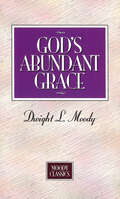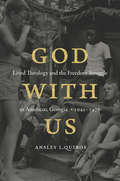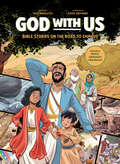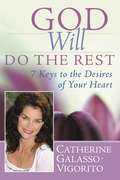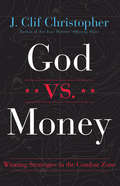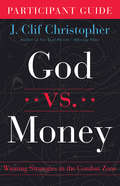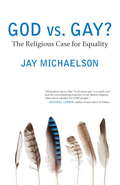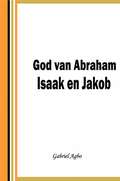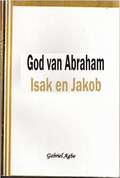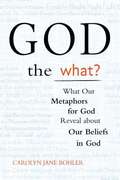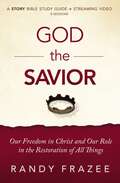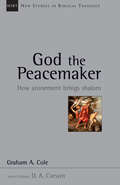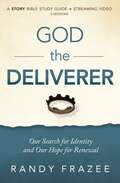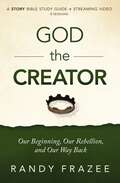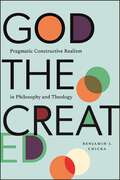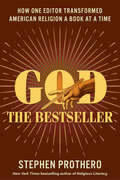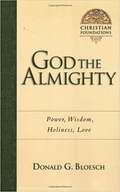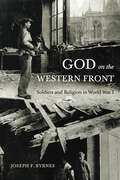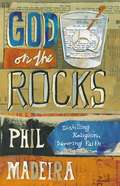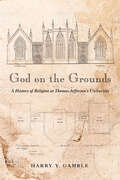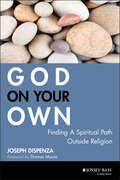- Table View
- List View
God's Abundant Grace (Moody Classics)
by Dwight L. Moody"MANY OF YOU HAVE BEEN KEPT OUT OF THE KINGDOM OF GOD BY YOUR GOOD WORKS."A startling thought, isn't it? Righteous acts and hard work may be the very things that lock the door to God's salvation, writes D. L. Moody. The faith versus works debate has gone on for two thousand years. Today the confusion continues. How many people, perhaps even you, believe that if they try hard enough, they may be able to escape judgment and receive God's gift of salvation? In God's Abundant Grace, D. L. Moody's words reach forward in time to strip away the layers we've added to God's salvation and lay bare the simple instruction: "To him that worketh not, but believeth to Him,... his faith is counted for righteousness."
God's Abundant Grace (Moody Classics)
by Dwight L. Moody"MANY OF YOU HAVE BEEN KEPT OUT OF THE KINGDOM OF GOD BY YOUR GOOD WORKS."A startling thought, isn't it? Righteous acts and hard work may be the very things that lock the door to God's salvation, writes D. L. Moody. The faith versus works debate has gone on for two thousand years. Today the confusion continues. How many people, perhaps even you, believe that if they try hard enough, they may be able to escape judgment and receive God's gift of salvation? In God's Abundant Grace, D. L. Moody's words reach forward in time to strip away the layers we've added to God's salvation and lay bare the simple instruction: "To him that worketh not, but believeth to Him,... his faith is counted for righteousness."
God'S Empire
by Hilary M. CareyIn God's Empire, Hilary M. Carey charts Britain's nineteenth-century transformation from Protestant nation to free Christian empire through the history of the colonial missionary movement. This wide-ranging reassessment of the religious character of the second British empire provides a clear account of the promotional strategies of the major churches and church parties which worked to plant settler Christianity in British domains. Based on extensive use of original archival and rare published sources, the author explores major debates such as the relationship between religion and colonization, church-state relations, Irish Catholics in the empire, the impact of the Scottish Disruption on colonial Presbyterianism, competition between Evangelicals and other Anglicans in the colonies, and between British and American strands of Methodism in British North America.
God with Us: Lived Theology and the Freedom Struggle in Americus, Georgia, 1942–1976
by Ansley L. QuirosFor many, the struggle over civil rights was not just about lunch counters, waiting rooms, or even access to the vote; it was also about Christian theology. Since both activists and segregationists ardently claimed that God was on their side, racial issues were imbued with religious meanings from all sides. Whether in the traditional sanctuaries of the major white Protestant denominations, in the mass meetings in black churches, or in Christian expressions of interracialism, southerners resisted, pursued, and questioned racial change within various theological traditions.God with Us examines the theological struggle over racial justice through the story of one southern town--Americus, Georgia--where ordinary Americans sought and confronted racial change in the twentieth century. Documenting the passion and virulence of these contestations, this book offers insight into how midcentury battles over theology and race affected the rise of the Religious Right and indeed continue to resonate deeply in American life.
God with Us: Bible Stories on the Road to Emmaus
by Matt MikalatosFollow God&’s story of love, hope, and rescue from Genesis to the Gospels in this captivating graphic novel—through stories told by Jesus himself.The long walk home after celebrating Passover in Jerusalem should be a joyful journey, but this year the travelers are sad and afraid. Then a mysterious stranger shows up and starts telling stories—from many years ago all the way up to the recent death of Yeshua (Jesus) on the cross—and the friends can&’t wait to hear more.This intriguing, funny, and heartfelt journey explores Scripture from Creation to the Resurrection through the eyes of curious children (and grown-ups!) walking with Yeshua on the Road to Emmaus.
God will do the Rest: 7 Keys to the Desires of Your Heart
by Catherine Galasso-Vigorito'The Key to the Kingdom of Heaven is also our Key to Happiness on Earth." Not only does Catherine Galasso believe this. . . her life is living proof of it. In GOD WILL DO THE REST, she explores seven qualities that have shaped her daily life and her life's mission: faith, love, persistence, hope, optimism, gratitude and forgiveness. Using stories from her own life experiences and inspiring principles from the Bible, Catherine encourages readers to take one step at a time down the pathway toward a richer and more meaningful future--one that affirms "I will do more than survive--I will thrive!" Catherine takes each key and through engaging examples explains the importance of that key, how to apply it, and the ways in which it will enrich readers' lives. She shows readers how to seize the struggles that come with each day and to turn them into opportunities for growth, joy, and peace.
God vs. Money: Winning Strategies in the Combat Zone
by J. Clif ChristopherGod and Money both make a lot of promises. God keeps all of God's promises, while Money keeps none. However, Money has better advertising, and we keep falling for it.Here's how to turn that trend around in your life and in the lives of those you lead.Chapters include:1. The Realities of the Situation2. The Preacher Must Be the Leader3. A Theology of Giving – Why We Do It4. Preach It5. Competing Is Not a Dirty Word6. Start Now and Don’t Quit7. You Have to Have a Budget8. Basic Fundraising Principles9. Making the Ask10. Big Money - Capital Campaigns11. Succeeding in a Capital Campaign12. Easy Money – Planned Giving13. Building, Banking and Bonds
God vs. Money Participant Guide: Winning Strategies in the Combat Zone
by J. Clif ChristopherThe God vs. Money Participant Guide and DVD (ISBN 9781501891571) provide a process for applying key principles from the main book, God vs. Money (ISBN 9781501868115), in the participant’s own ministry context. This study is for leaders in churches and other ministry settings who have responsibility for capital campaigns, budgets, stewardship, planned giving, and other financial concerns. The typical study groups include finance committees, stewardship teams, foundation boards, and finance-related staff teams. The study is also recommended for continuing education of pastors and other church leaders. A copy of the main book (God vs. Money, ISBN 9781501868115) is required for each participant and a copy of the DVD (ISBN 9781501891571) is required for each group. Prior to each group session, participants should read a section of the book. Sessions start with a 7-10 minute video featuring Clif Christopher. Using the Guide, participants completes a variety of activities focused on application of key points from the prescribed reading. This may include discussion questions, personal reflection, group problem-solving activities, and other actions. The Guide serves as a workbook, giving each participant a place to record their thoughts and insights from the group, and to plan next steps.
God vs. Gay? The Religious Case for Equality
by Jay MichaelsonDoes the Bible prohibit homosexuality? No, says Bible scholar and activist Jay Michaelson. But not only that: Michaelson also shows that the vast majority of our shared religious traditions support the full equality and dignity of LGBT people. In this accessible, passionate, and provocative book, Michaelson argues for equality, not despite religion but because of it.From the Hardcover edition.sex families will strengthen, not threaten, the values religious people hold dear. This is an important book for anyone who has wrestled with questions of religion and homosexuality: parents and pastors, believers and skeptics, advocates of "gay rights" and opponents of them. Whatever your views on religion and sexual diversity, God vs. Gay is a plea for a more compassionate, informed conversation--and a first step toward creating one.From the Hardcover edition.
God van Abraham,Isaak en Jakob
by Gabriel Agbo josepha van den BrinkGod van Abraham,Isaak en Jakob . Een geweldig boek over Godsverbonds beloften falen niet. Dit boek is geschreven om je te helpen bereiken al God's beloftes voor jouw leven. Het is een voorzichtig uitgewerkte studie, met persoonlijke getuigenissen over de mogelijkheid en bereidwilligheid van god om zijn woorden tot stand te brengen voor ons. Hij zegt dat hij elk woord niet ledig terug laat keren. Hier kijken we critisch naar de dynamische en goddelijke belofte; hoe die tot stand kwam, gegroeid en onderhouden en tot vruchtbaarheid kwam. Elke verbonds belofte heeft zijn begin,tijdsbepaling en condities. we moeten dit altijd weten om instaat te zijn om perfect en comfortabel in te toetsen God's wil voorons leven. Inderdaad alle dingen zijn mogelijk met God.
God van Abraham, Isak en Jakob
by Gabriel Agbo Mignionette FairGod se verbondsbeloftes stel nooit teleur nie. Hierdie boek sal jou help om al God se beloftes vir jou lewe te bereik. Dit is ʼn omvattende studie met persoonlike getuienisse oor die vermoë en gewilligheid van God om al Sy woorde rakend ons uit te voer. Hy het gesê Hy waak oor Sy woorde om hulle te laatgeskied. In hierdie boekkyk ons krities na die dinamika van ʼn goddelike belofte en hoe dit tot stand kom, in stand gehou en versorg word tot verwerkliking. Elke verbondsbelofte het ʼn begin, tydsberekening en voorwaardes. Ons moet dit altyd onthou om in staat te wees om perfek en gemaklik by God se wil vir ons lewens in te skakel. Inderdaad, by God is alles moontlik!
God the What?: What Our Metaphors for God Reveal about Our Beliefs in God
by Carolyn Jane Bohler<p>"We do not have to let go of one sense of God to take up another. Neither do we need to go about challenging old metaphors. What is crucial is to find a metaphor--or two, or six--that creatively point toward what we believe." --from Chapter 1 <p>Let Carolyn Jane Bohler inspire you to consider a wide range of images of God in order to refine how you imagine God to have and use power, and how God wills and makes divine will happen--or not. By tapping into your God-given ability to re-imagine God, you will have a better understanding of your own beliefs and how you, God and the world relate to each other. <p>Wonderfully fresh and down to earth, Bohler uses playful images, moving stories and solid scholarship to empower you to break free of old habits and assumptions, whatever your faith tradition. She encourages you to explore new names for God that are not only more consistent with what you believe, but will also deepen and expand your experience of God. Think about ... <p> <li>God the Choreographer of Chaos <li>God the Nursing Mother <li>God the Jazz Band Leader <li>God the Divine Blacksmith <li>God the Divine Physical Therapist <li>God the Team Transformer <li>... and more</li> </p>
God the Savior Bible Study Guide plus Streaming Video: Our Freedom in Christ and Our Role in the Restoration of All Things (The Story Bible Study Series)
by Randy FrazeeGod goes to great lengths to rescue lost and hurting people. In this 8-session video Bible study (streaming included), enter the culmination of God's complex plan to deliver his people in the person of Jesus Christ, our Savior. Salvation is what the story of the Bible is all about: the final goal of God's narrative. But throughout the Bible, there are two parallel dramas unfolding:The lower story, which describes the events from our human perspective.The upper story, which reveals how the events unfold from God's perspective.The goal of the God the Savior Bible study is to introduce you to these lower and upper stories as told in the New Testament. As you read these stories—featuring characters such as Mary and Joseph, the Twelve Disciples, John the Baptist, Mary Magdalene, and the central figure, Jesus Christ—you will see how God has been weaving our lower story into the greater upper story that he has been writing.This study guide has everything you need for a full Bible study experience, including:The study guide itself—with discussion and reflection questions, video notes, and Scripture readings.An individual access code to stream all eight video sessions online (you don't need to buy a DVD!).Sessions include:Jesus' Birth and Ministry (Matthew–John)Jesus, the Son of God (Matthew–John)The Hour of Darkness (Matthew–John)The Resurrection (Matthew–John)New Beginnings (Acts 1–12)Paul's Mission (Acts 13–18)Paul's Final Days (Acts 19–28)The End of Time (Revelation)The God the Savior Study Guide is part of The Story Bible Study Series: a three-part Bible study drawn from Randy Frazee's bestselling The Story, which reveals the Bible as a single, continuous narrative of God and his people.Streaming video access code included. Access code subject to expiration after 12/31/2027. Code may be redeemed only by the recipient of this package. Code may not be transferred or sold separately from this package. Internet connection required. Void where prohibited, taxed, or restricted by law. Additional offer details inside.
God the Peacemaker: How Atonement Brings Shalom (New Studies in Biblical Theology #Volume 25)
by Graham ColeWhat does God intend for his broken creation? In this New Studies in Biblical Theology volume, Graham A. Cole seeks to answer this question by setting the atoning work of the cross in the broad framework of God's grand plan to restore the created order, and places the story of Jesus, his cross and empty tomb within it. Since we have become paradoxically the glory and garbage of the universe, our great need is peace with God and not just with God, but also with one another. Atonement brings shalom by defeating the enemies of peace, overcoming both the barriers to reconciliation and to the restoration of creation through the sacrifice of Christ. The "peace dividend" that atonement brings ranges from the forgiveness of sins for the individual to adoption into the family of God. Addressing key issues in biblical theology, the works comprising New Studies in Biblical Theology are creative attempts to help Christians better understand their Bibles. The NSBT series is edited by D. A. Carson, aiming to simultaneously instruct and to edify, to interact with current scholarship and to point the way ahead.
God the Holy Trinity: Reflections on Christian Faith and Practice (Beeson Divinity Studies)
by Timothy GeorgeGod the Holy Trinity brings together leading scholars from diverse theological perspectives to reflect on various theological and practical aspects of the core Christian doctrine of the Trinity. Throughout, the contributors highlight the trinitarian shape of spiritual formation. The esteemed lineup of contributors includes Alister E. McGrath; Gerald L. Bray; James Earl Massey; Avery Cardinal Dulles, S.J.; Frederica Mathewes-Green; J. I. Packer; Timothy George; Ellen T. Charry; and Cornelius Plantinga Jr. This book will appeal to students, church leaders, and interested laity. It is the second book in the Beeson Divinity Studies series.
God the Deliverer Bible Study Guide plus Streaming Video: Our Search for Identity and Our Hope for Renewal (The Story Bible Study Series)
by Randy FrazeeGod goes to great lengths to rescue lost and hurting people. In this 8-session video Bible study (streaming included), enter the unfolding progression of the Old Testament and the advancement of God's complex plan to deliver his people. Deliverance is what the story of the Bible is all about. But throughout the Bible, there are two parallel dramas unfolding:The lower story, which describes the events from our human perspective.The upper story, which reveals how the events unfold from God's perspective.The goal of the God the Deliverer Bible study is to introduce you to these lower and upper stories as told in the Old Testament books of 1 Samuel through Malachi and the thread of deliverance that weaves through them both.As you read these narratives—featuring characters such as Samuel, Saul, David, Jeremiah, Daniel, Esther, Ezra, and Nehemiah—you will see how God has been weaving our lower story into the greater upper story that he has been writing.This study guide has everything you need for a full Bible study experience, including:The study guide itself—with discussion and reflection questions, video notes, and Scripture readings.An individual access code to stream all eight video sessions online (you don't need to buy a DVD!).Sessions include:Standing Tall, Falling Hard (1 Samuel 1–15)From Shepherd to King (1 Samuel 16–2 Samuel 24)The King Who Had It All (1 Kings 1–11)A Kingdom Torn in Two (1 Kings 12–2 Kings 16)The Kingdom Fall (2 Kings 17–25)Daniel in Exile (Daniel)The Queen of Beauty and Courage (Esther)The Return Home (Ezra–Nehemiah)The God the Deliverer Study Guide is part of The Story Bible Study Series: a three-part Bible study drawn from Randy Frazee's bestselling The Story, which reveals the Bible as a single, continuous narrative of God and his people.Streaming video access code included. Access code subject to expiration after 12/31/2027. Code may be redeemed only by the recipient of this package. Code may not be transferred or sold separately from this package. Internet connection required. Void where prohibited, taxed, or restricted by law. Additional offer details inside.
God the Creator Bible Study Guide plus Streaming Video: Our Beginning, Our Rebellion, and Our Way Back (The Story Bible Study Series)
by Randy FrazeeHeaven and earth are woven more closely together than we might think. In this 8-session video Bible study (streaming included), enter the creation of the world and the first movements of God's perfect plan to deliver his people.Throughout the Bible—from its very first pages to the culmination of Christ's return—there are two parallel dramas unfolding:The lower story, which describes the events from our human perspective.The upper story, which reveals how the events unfold from God's perspective.The objective of God the Creator—the first in a series of three small-group studies in The Story series—is to introduce you to these lower and upper stories as told in the Old Testament books of Genesis through Ruth. As you read these narratives—featuring characters such as Adam, Eve, Abraham, Sarah, Joseph, Moses, Joshua, Gideon, and Ruth—you will see how God has been weaving our lower story into the greater upper story that he has been writing.This study guide has everything you need for a full Bible study experience, including:The study guide itself—with discussion and reflection questions, video notes, and Scripture readings.An individual access code to stream all eight video sessions online (you don't need to buy a DVD!).Sessions include:The Beginning of Life as We Know It (Genesis 1–11)God Builds a Nation (Genesis 12–36)From Slave to Deputy Pharaoh (Genesis 37–50)Deliverance (Exodus 1–17)Wanderings (Exodus 18–Numbers 27)The Battle Begins (Joshua 1–24)A Few Good Men . . . and Women (Judges 1–21)The Faith of a Foreign Woman (Ruth 1–4)The God the Creator Study Guide is part of The Story Bible Study Series: a three-part Bible study drawn from Randy Frazee's bestselling The Story, which reveals the Bible as a single, continuous narrative of God and his people.Streaming video access code included. Access code subject to expiration after 12/31/2027. Code may be redeemed only by the recipient of this package. Code may not be transferred or sold separately from this package. Internet connection required. Void where prohibited, taxed, or restricted by law. Additional offer details inside.
God the Created: Pragmatic Constructive Realism in Philosophy and Theology
by Benjamin J. ChickaIn God the Created, Benjamin Chicka develops a method of inquiry and program for theology that he labels "pragmatic constructive realism." While influenced most heavily by American pragmatism, especially that of Charles S. Peirce, Chicka’s method draws upon a variety of sources, ranging from Plato to Karl Popper, Paul Tillich, and the field of biosemiotics. Chicka presents pragmatic constructive realism as a means of moving past binary debates between realism and antirealism in both philosophy and theology, and its fruitfulness is displayed by examining the philosophical theologies of John Cobb and Robert Cummings Neville. The result of that engagement is a novel hypothesis about God that embraces legitimate criticisms of both process theology (Cobb) and ground-of-being theology (Neville) while integrating insights from both ways of thinking. God's transcendence and immanence, indeterminacy and determinacy are fully affirmed. The entire argument serves as an example of why a fallible and pluralistic form of theology, one that embraces and learns from difference instead of trying to eliminate it, is important for the future of theology.
God the Bestseller: How One Editor Transformed American Religion a Book at a Time
by Stephen ProtheroNew York Times bestselling author and acclaimed religion scholar, Stephen Prothero, captures the compelling and unique saga of twentieth-century America on an identity quest through the eyes and books of one of the most influential editors of the day—a search, born of two world wars, for resolution of our divided identity as a Christian nation and a nation of religions.One summer evening in 1916 in Blanchester, Ohio, a sixteen-year-old farm boy was riding his horse past the town cemetery. The horse reared back and whinnied, and Eugene Exman saw God. For the rest of his life, he struggled to recreate that moment. Through a treasure of personal letters and papers, God, the Bestseller explores Exman’s personal quest. A journey that would lead him in the late 1920s to the Harper religious books department, which he turned during the Great Depression into a money-making juggernaut and the country’s top religion publisher. Exman’s role in the shaping of American religion is undeniable. Here was a man who was ahead of his time and leading the rest of the nation through books on a spiritual exploration. Exman published bestsellers by the controversial preacher Harry Emerson Fosdick, the Catholic radical Dorothy Day, the Civil Rights pioneer Howard Thurman, and two Nobel laureates: Albert Schweitzer and Martin Luther King Jr. Exman did not just sit at a desk and read. In addition to his lifelong relationships with the most influential leaders of the day, Exman was on a spiritual journey of his own traversing the world in search of God. He founded a club of mystics, dropped acid in 1958, four years before Timothy Leary. And six years before The Beatles went to India, he found a guru there in 1962. In the end, this is the story of the popularization of the religion of experience—a cultural story of modern America on a quest of its own. Exman helped to reimagine and remake American religion, turning the United States into a place where denominational boundaries are blurred, diversity is valued, and the only creed is that individual spiritual experience is the essence of religion.
God the Almighty: Power, Wisdom, Holiness, Love
by Donald G. BloeschVoted one of Christianity Today's 1996 Books of the Year! The doctrine of God is receiving renewed and vigorous attention among theologians. Even a cursory examination of recent scholarship reveals what leading evangelical theologian Donald Bloesch describes as "a mounting controversy over the concept of God." God is variously portrayed as vulnerable (Jürgen Moltmann, Clark Pinnock), as lover (Norman Pittenger, Ronald Goetz), as friend (Alfred North Whitehead, Sallie McFague) and as empowerer (Rosemary Radford Ruether). Bloesch agrees that many of these proposals have some biblical merit. But what is lacking, he argues, "is a strong affirmation of the holiness and almightiness of God." So in this volume, which he considers the most important in his Christian Foundations series, Bloesch offers cogent criticisms and corrective insights on both classical and recently advanced views of God. He seeks to hold in faithful tension "the polarities that are reflected in God's nature and activity--his majesty as well as his vulnerability, his sovereignty as well as his grace, his wholly otherness as well as his unsurpassable closeness, his holiness as well as his love."
God on the Western Front: Soldiers and Religion in World War I
by Joseph F. ByrnesFrom 1914 to 1918, religious believers and hopeful skeptics tried to find meaning and purpose behind divinely willed destruction. God on the Western Front is a history of lived religion across national boundaries, religious affiliations, and class during World War I, utilizing an expansive record of primary sources.Joseph F. Byrnes takes readers on a tour of the battlefields of France, listening to the words of German, French, and English soldiers; going behind the lines to hear from the men and women who provided pastoral and medical care; and reviewing the religious writings of priests, bishops, ministers, and rabbis as they tried to make sense of it all. The story begins with citizens at home as they responded to the obligation to make war and then focuses on the “God-talk” and “nation-talk” that soldiers used to express their foundational religious experiences. Byrnes’s study attends to the words of average men who struggled to articulate their religious sentiments, alongside the generals Helmuth von Moltke, Ferdinand Foch, and Douglas Haig and the soldier theologians Franz Rosenzweig, Paul Tillich, Pierre Teilhard de Chardin, and Geoffrey Studdert Kennedy. In doing so, he shows how religious and battle experience are intertwined and showcases the wide range of spiritual responses that emerged across boundaries.Going beyond the typical constraints of studies focused either on one nation or one confessional affiliation, Byrnes’s international and interfaith approach breaks new ground. It will appeal to scholars and students of modern European history, religious history, and the history of war.
God on the Rocks
by Phil MadeiraMusician and songwriter Phil Madeira turns his talent for evocative lyricism from the stage to the page as he invites us to wander with him on his relentless search for God. From a joke involving a glass eye in a family that doesn't always see eye-to-eye, a judgmental "Grandmonster" who makes an (almost) redeeming connection in her final moments, or a crumbling marriage and the surprise of new love, Madeira's raw and tender stories illustrate the journey we all share, along with wise reflections to get through it. Roaming from his evangelical roots to discover a successful career in Americana music, Madeira boils away the detritus of religion to discover a faith "on the rocks": sometimes leaving him stranded on the rocky shore, sometimes savored like a smooth drink on a summer's day, but always leading to a God "not worrying about changing or chastising his broken children, but singing in a low, guttural hymn, forged in the heat of his passion for humans, a God almighty love song." Just like a sweet old hymn can rekindle even a doubting cynic's longing for God, Madeira's beckoning voice can turn a wandering heart toward home with laughter and hope.
God on the Grounds: A History of Religion at Thomas Jefferson's University
by Harry Y. GambleFree-thinking Thomas Jefferson established the University of Virginia as a secular institution and stipulated that the University should not provide any instruction in religion. Yet over the course of the nineteenth century and into the early twentieth, religion came to have a prominent place in the University, which today maintains the largest department of religious studies of any public university in America. Given his intentions, how did Jefferson's university undergo such remarkable transformations?In God on the Grounds, esteemed religious studies scholar Harry Gamble offers the first history of religion’s remarkably large role—both in practice and in study—at UVA. Jefferson’s own reputation as a religious skeptic and infidel was a heavy liability to the University, which was widely regarded as injurious to the faith and morals of its students. Consequently, the faculty and Board of Visitors were eager throughout the nineteenth century to make the University more religious. Gamble narrates the early, rapid, and ongoing introduction of religion into the University’s life through the piety of professors, the creation of the chaplaincy, the growth of the YMCA, the multiplication of religious services and meetings, the building of a chapel, and the establishment of a Bible lectureship and a School of Biblical History and Literature. He then looks at how—only in the mid-twentieth century—the University began to retreat from its religious entanglements and reclaim its secular character as a public institution. A vital contribution to the institutional history of UVA, God on the Grounds sheds light on the history of higher education in the United States, American religious history, and the development of religious studies as an academic discipline.
God on Your Own: Finding A Spiritual Path Outside Religion
by Joseph DispenzaIn this spiritual self-help memoir, a former Roman Catholic monk recounts his journey away from religion toward his own personal spirituality. After spending eight years in a monastery, Joseph Dispenza walked away from his life as a monk—and the religion of his youth—in search of a different kind of spiritual path. Outside the confines of organized religion, Dispenza was able to create a spiritual life that gives direction and meaning to all he does and all he is. God on Your Own is a book for anyone who has left (or is thinking of leaving) organized religion but wants to continue on a spiritual path. Dispenza, a noted author and retreat leader, provides a spiritual road map for those who want to make the transition from conventional religion toward a richer and more satisfying direct relationship with the Source, without rules, dogmas, or doctrines. Throughout the book, Dispenza offers wise, compassionate guidance, speaking as one seeker to another. He has made this journey himself, gleaning spiritual truth from across traditions and practices.
